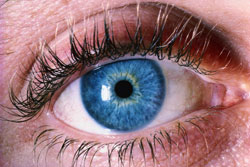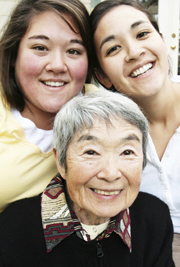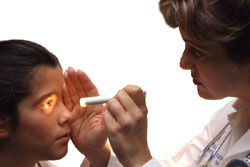- What is Glaucoma?
- Statistics
- Risk Factors
- Progression
- Symptoms
- Clinical Examination
- How is it Diagnosed
- Prognosis
- Treatment
- References
What is Glaucoma?
Glaucoma refers to a group of disorders affecting the eyes. These disorders are characterised by increased pressure within the eye that causes damage to the eye tissues and the optic nerve, which is the main nerve controlling vision. Damage to the eye and optic nerve in glaucoma causes visual problems.There are several types of glaucoma including:
- Primary open-angle glaucoma;
- Primary angle-closure glaucoma;
- Congenital and juvenile glaucoma; and
- Secondary glaucoma as a complication of other medical conditions.
The two most common of these are primary open-angle glaucoma (POAG) and primary angle-closure glaucoma (PACG.) The angle refers to a small area in the front of the eye through which fluid from the eye normally drains.
Therefore in primary-open angle glaucoma the angle of the eye is open although it does not function properly to drain the fluid. This type of glaucoma usually affects both eyes and begins slowly in adulthood. Few signs and symptoms are usually noticed until late in the disease.
In primary-angle closure the angle of the eye is obstructed and closed. People who develop PACG glaucoma are usually predisposed to develop this and are often farsighted. Patients with PACG are more likely to present with signs and symptoms of the disease such as a dilated pupil, red eyes, nausea or vomiting.
Congenital and juvenile glaucoma refer to the type of glaucoma that occurs in babies or children. These childhood glaucoma diseases may be present at birth or develop following infection, eye trauma or eye cancer.
Secondary glaucoma can occur following a number of different diseases. In adults it may be seen following infection of the eye, trauma, steroid drug therapy and in a variety of other conditions.
Statistics

Primary open-angle glaucoma
It is estimated that about 2-3% of people living in Australia who are aged 40 years and over, have POAG. The incidence of POAG significantly increases with age, with an incidence of over 4.1% in those 80 years and over. Rates are higher in Africa with prevalence varying between 1-8%, while high prevalence rates of 7-9% are reported in the Caribbean where the population comes from Western Africa originally.
Primary angle-closure glaucoma
PACG is much more common in people of non-Caucasian backgrounds including those of Eskimo, Chinese or Asian Indian descent, with rates of 2.6% in Eskimo’s, 1.37% in Chinese people and 4.33% in Indians. In Caucasian populations the rate of disease is less than 1%, with one study reporting a rate of 0.09% in an Australian population.
Congenital and juvenile glaucoma
Glaucoma in children and infants is seen much less frequently than in adults. The incidence of congenital glaucoma is about 1 in 5,000 to 1 in 10,000 live births.
Secondary glaucoma
The overall rate of secondary glaucoma is about 0.5% although studies on secondary glaucoma are limited. Similar to the other forms of glaucoma the prevalence of secondary glaucoma is also significantly increased with age.
Risk Factors
There are a number of predisposing risk factors for glaucoma. These can be grouped into demographic, ocular, familial, systemic or genetic factors.
Demographic factors
Age and ancestry are well-established predisposing factors.The prevalence of POAG rises steadily with age and this rise is particularly steep in people of European descent.People of African descent are also at an increased risk and often present earlier.In PACG, non-Caucasian people and females are at greater risk of developing the disease.
Familial factors

Ocular factors
The pressure within the eye is a strong contributing factor. Higher eye pressures at baseline are a predictive risk factor for POAG. Lowering the eye pressure has been shown to reduce the risk of progression and delay the onset.
A thinner cornea is also an important predisposing factor in the development of POAG, although more research is needed on why this is the case.
There are also predisposing ocular factors for PACG. People who are farsighted are at greater risk of this condition as their eyeball is shorter which causes the angle of the eye to be blocked.
Systemic factors
Factors related to the pressure within the blood vessels of the eye have been found to be predictive of POAG. While diabetes mellitus is strongly linked to increased eye pressure it is unclear whether this predisposes to POAG.
It is not fully understood as to whether systemic hypertension, migraines and short-sightedness are predisposing factors for POAG.
Genetics
Several genetic risk factors have been linked to POAG. One of these is the MYOC gene, of which 3-5% of people who have a defective MYOC gene have been shown to have POAG. Variations in the OPA1 gene have also been identified and linked to POAG.
Genetic factors play a role in several cases of congenital glaucoma with mutations identified in the CYPB1 gene.
Lifestyle factors

Other lifestyle behaviours such as alcohol consumption, the use of hormone replacement therapy (HRT) and the oral contraceptive pill have not been associated with an increased risk of developing glaucoma.
Progression
The natural history of glaucoma is not fully defined and depends on the type of glaucoma as well as the age and ethnicity of the patient. For some people POAG may not progress or the progression may be slow. Others may experience more rapidly progressing disease, leading to reduced vision-related function within 10 years. Those with higher eye pressures, poorer vision, and those who are older, tend to be at greater risk for worse outcomes and more rapid progression of glaucoma.
Symptoms
Many people with glaucoma of the open-angle type will report no signs, symptoms or visual complaints until late in the disease course.
Attention should be paid to the past eye history. Affected individuals may have a history of eye pain or redness, multicoloured halos, headache, previous eye disease including cataracts, infection, diabetes or blood vessel problems.A history of previous eye surgery and head injuries may also be noted.
It is also important to know about if there are any illnesses, medications taken (including hypertensive medications and corticosteroids) or whether there is a family history of glaucoma.
As the glaucoma progresses people with glaucoma may report visual complaints, typically that there is reduced vision near the edges of their field of vision. The blindspot may be enlarged and individuals may report problems seeing as a result of this.
Clinical Examination

The optic nerve should be examined using a slit-lamp and the back of the eye can be examined with an ophthalmoscope. The clinician should take some measurements of the back of the eye to determine the risk of developing glaucoma and loss of vision.
In PACG, assessment of the angle of the eye must be undertaken to see if there is a blockage.
Photographs of the back of the eye may be taken for future reference or comparison over time.
How is it Diagnosed
Initial tests should be undertaken to exclude other causes of eye disease. These tests should include a blood test, looking at the full blood count (FBC), erythrocyte sedimentation rate (ESR), serology for syphilis, and if suggested by the history imaging of the head.
Once the other causes of eye problems have been ruled out specific tests for glaucoma should be undertaken. Tonometry should be performed, which is a test done to determine the pressure within the eye. Eye pressures can vary throughout the day and are normally highest in the morning therefore the time that the test was conducted should be recorded.
Gonioscopy is a test performed to examine the angle the eye. This should be undertaken to determine if the glaucoma is open-angle or closed-angle and to rule out other forms of glaucoma such as secondary glaucoma. Pachymetry to measure the thickness of the cornea is also recommended.
Imaging studies should be undertaken. Particularly photographs of the back of the eye should be taken and these should be compared over time to track the progression.
There are several new techniques that can document the thickness and status of the optic nerve such as laser scanning.
Prognosis

For those who have PACG, some patients may develop complications of the disease including permanent reduction in vision, repeated episodes and malignant glaucoma, which may progress to blindness. Another complications of PACG is that the central blood vessel supplying the eye may become blocked. If adequate treatment is given most patients will recover any acute loss of vision although people of Asian descent with PACG may have poorer outcomes due to more severe attacks.
The outcome for childhood, infant glaucoma and secondary glaucoma is very much dependant on the type of glaucoma and the associated disease or condition. Congenital glaucoma, present at birth, has a much poorer outcomes for the child than infant glaucoma, which develops in the first few years of life.Childhood and infant glaucoma often result in poorer outcomes than adult glaucoma because there is damage to the visual system, which is undergoing development.
Treatment
Primary Open-Angle Glaucoma
The aim of treatment is to reduce the pressure in the eye to less than 21mmHg to prevent further loss of vision throughout the person’s life.
Medical treatment

- Alpha-agonists – such as Brimonidine. This agent decreases production fluid in the of the eye. However there are side effects associated with this including dry mouth, fatigue and drowsiness.
- Beta-blockers – such as Betaxolol drops, which also reduce the production of fluid. They should be used carefully in those with asthma or heart failure.
- Carbonic anhydrase inhibitors – inhibit an enzyme, carbonic anhydrase, to reduce the secretion fluid. Dorzolamide HCl is an example but may be associated with feeling unwell, loss of appetite, mood changes and abnormalities in serum electrolytes.
- Miotic agents/Parasympathomimetics – such as Pilocarpine. These increase the outflow of eye fluid. Pilocarpine may cause blurring of vision and brow ache.
- Prostaglandin analogs – such as Latanoprost. These agents increase the outflow of fluid. They may cause the coloured part of the eye and the lashes to go darker.
Medications are recommended if there are signs of damage, if the disease appears to be progressing and after consideration of the risks versus the benefits of therapy for the patient.
Monitoring of the response to the medications is required and is achieved by regular visual field testing, ophthalmoscopic examination and photographs of the optic nerve. If new damage to the optic nerve is evident then the treatment and target eye pressure may require review.
Surgery
Surgery may be indicated if the disease worsens, despite optimal medical management. There are a number of surgical options.
- A flap-valve trabeculectomy is a common procedure performed for glaucoma. This procedure involves creating an alternative drainage path for the eye fluid therefore lowering the eye pressure. However, the procedure may be associated with failure, infection of the eye, bleeding and cataract development.
- The argon laser trabeculoplasty procedure is another technique used, but this procedure is generally a short-term option.
- Several other surgical treatments include selective laser trabeculoplasty and a drainage implant, such as a tube or shunt to drain the fluid from the eye.
- There are also novel surgical techniques on the horizon.
Primary angle-closure glaucoma
Medical management for PACG is similar to that of POAG. However PACG more often presents with an acute attack, therefore acute management strategies should focus on reducing the eye pressure, suppressing the inflammation and reversing the blocked or closed angle.In the event of an attack of PACG the patient should be placed on their back position, given pain relief and anti-nausea medication if there is nausea and vomiting.The final treatment of PACG is considered to be surgery, with a procedure known as a laser peripheral iridotomy (LPI) when the patient is stable.
Close follow-up is important after either medical or surgical treatment, for all types of glaucoma. The frequency of follow up visits and monitoring depends on the pressure within the eye, the extent of damage to the eye and the characteristics of the patient.
Lifestyle modifications
In addition to the specific medications and surgical procedures there are a number of lifestyle modifications and recommendations that can contribute to the overall management and control of glaucoma.
Physical activity

Vigorous exertion should be performed with caution, due to the role this may have in acutely increasing eye pressure. However light to moderate exercise should not be discouraged in those with glaucoma, due to both the possible reduction in eye pressure and the general health benefits that exercise provides.
Nutrition
A healthy diet should always be recommended although there is little specific evidence that particular dietary measures prevent or control glaucoma. There is some data that suggests a diet high in fruit and vegetables and low in fat may be associated with a reduced risk of glaucoma, however these relationships require further investigation.
Blood pressure
In terms of blood pressure control and glaucoma, some studies have found an association between elevated blood pressure and eye pressure, while other reports suggest no association. Therefore a healthy approach should be undertaken with blood pressure within normal ranges in order to optimise health and wellbeing.
Alternative and complimentary medicines
A number of alternative and complementary medicines have also been investigated in terms of their role in preventing the onset or progression of glaucoma. There may be a potential therapeutic benefit for patients with glaucoma associated with lipoic acid, vitamin B12 and magnesium.
Bilberry, a European blueberry is sold in many natural food stores as a glaucoma remedy, but the evidence suggests it is not effective at preventing or treating glaucoma.
It is important not to take any alternative and complementary substances such as herbs or supplements, without consultation with a doctor beforehand.
Living with glaucoma
Glaucoma may make the eyes sensitive to light and glare and the medications described above may worsen this problem and increase the eye’s sensitivity further. Therefore protective sunglasses are recommended for general eye-care and protection.There is some suggestion that yellow, amber and brown lenses are recommended because they block the shorter and more powerful wavelengths, however it is also believed that any dark lenses are effective at cutting the glare and protecting the eyes.
Relaxation techniques may be useful to counteract daily psychosocial stresses and maintain psychological health and wellbeing.
References
- Cotran RS, Kumar V, Collins T. Robbins Pathologic Basis of Disease. 7th ed. Philadelphia: W.B. Saunders Company; 2004.
- Leske MC. Open-glaucoma – an epidemiologic overview. Ophthalmic Epidemiol. 2007; 14(4):166-72.
- Coleman AL. Glaucoma [Review]. Lancet. 1999; 354(9192): 1803-10.
- Ho CL, Walton DS. Primary congenital glaucoma. J Pediatr Ophthalmol Strabismus. 2004; 41(5): 271-88.
- Yamamoto T, Iwase A, Araie M, Suzuki Y, Abe H, Shirato S et al. The Tajimi Study report 2: prevalence of primary angle closure and secondary glaucoma in a Japanese population. Ophthalmology. 2005; 112(10): 1661-9.
- Mukesh BN, McCarty CA, Rait JL, Taylor HR. Five-year incidence of open-angle glaucoma: The visual impairment project. Ophthalmology. 2002; 109(6): 047-51.
- Ng WS, Ang GS, Azuara-Blanco A. Primary angle closure glaucoma: a descriptive study in Scottish Caucasians. Clin Experiment Ophthalmol. 2008; 36(9): 847-51.
- Rivera JL, Bell NP, Feldman RM. Risk factors for primary open angle glaucoma progression: what we know and what we need to know. Curr Opin Ophthalmol. 2008; 19(2):102-6.
- Leske MC, Hyman L. Predictors of long-term progression in the early manifest glaucoma trial. Ophthalmology. 2007; 114(11):1965-72.
- Fan BJ, Leung YF, Wang N, Lam SC, Liu Y, Tam OS et al. Genetic and environmental risk factors for primary open-angle glaucoma. Chin Med J (Engl). 2004; 117(5):706-10.
- Doshi V, Ying-Lai M, Azen SP, Varma R. Sociodemographic, family history, and lifestyle risk factors for open-angle glaucoma and ocular hypertension. Ophthamology. 2008; 115(4): 639-647.
- Klein BE, Klein R, Ritter LL. Relationship of drinking alcohol and smoking to prevalence of open-angle glaucoma: the Beaver Dam Eye Study. Ophthalmology. 1993;100:1609-13.
- US Preventative Services Task Force. Guide to Clinical Preventive Services. 2nd ed. Virginia. International Medical Publishing. 1996.
- Burr J, Azuara-Blanco A, Avenell A. Medical versus surgical interventions for open angle glaucoma. (Cochrane Review) In: The Cochrane Library. Issue 2, 2004.
- Ng WS, Ang GS, Azuara-Blanco A. Laser peripheral iridoplasty for angle-closure. (Cochrane Review) In: The Cochrane Library. Issue 3, 2008.
- Kipp MA. Childhood Glaucoma. Pediatric Clinics of North America. 2003;50(1):89-104.
- San Laureano J. When is glaucoma really glaucoma? Clin Exp Optom. 2007; 90(5):376-85.
- Qureshi IA. The effects of mild, moderate, and severe exercise on intraocular pressure in glaucoma patients. Japanese Journal of Physiology.1995; 45(4):561-9.
- Coleman AL, Stone KL, Kodjebacheva G, Yu F, Pedula KL, Ensrud KE et al. Glaucoma risk and the consumption of fruits and vegetables among older women in the study of osteoporotic fractures. American Journal of Ophthalmology. 2008;145(6):1081-9.
- Head KA. Natural therapies for ocular disorders, part two: cataracts and glaucoma. Alternative Medicine Review. 2001; 6(2):141-66.
- Ophthalmology. What you can do to protect your eyes. Harvard Health Letter. 2001;26(12):1-3.
All content and media on the HealthEngine Blog is created and published online for informational purposes only. It is not intended to be a substitute for professional medical advice and should not be relied on as health or personal advice. Always seek the guidance of your doctor or other qualified health professional with any questions you may have regarding your health or a medical condition. Never disregard the advice of a medical professional, or delay in seeking it because of something you have read on this Website. If you think you may have a medical emergency, call your doctor, go to the nearest hospital emergency department, or call the emergency services immediately.







